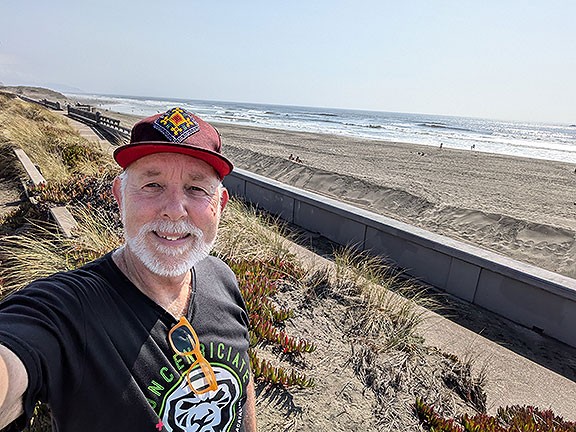
Visiting the Pacific Ocean in late August, an easy bike ride from home…
Last December I wrote a bit about my discovering more deep history around the Pacific. I neglected to mention then my pal Tina’s remarkable atlas Sea Change: An Atlas of Islands in a Rising Ocean. In it she makes her way from island to island around the planet, giving capsule histories and likely scenarios as the oceans continue their inexorable rise. California’s history is fully intertwined with that of the Philippines, Hawaii, Japan, Korea, China, India and the rest of what is lumped together as Asia and the Pacific. Tina’s atlas doesn’t try to untangle all those complicated histories, though she notes many important pieces in passing. In the past few weeks I’ve had the pleasure of diving rather deeply into this.
An incredible book, well over 500 pages, is Alfred McCoy’s 2009 opus Policing America’s Empire: The United States, the Philippines, and the Rise of the Surveillance State. He has popped up in prior blog posts of mine as the author of various works describing the steady unraveling of the US empire (he originally made his name with The Politics of Heroin in Southeast Asia that revealed the role of the CIA in running heroin during the Vietnam war). This book on the Philippines and US colonialism is a tour de force, and a product of 40 years of close research McCoy carried out during most of his academic life. It covers the initial seizure of the Philippines in 1898 and betrayal of the ongoing war of liberation there, through the many years of developing and perfecting technologized systems of counterinsurgency and colonial repression, up to the post-WWII granting of formal independence, the Marcos martial law regime, the post-martial law “democratic” governments up to Gloria Arroyo’s in the early 2000s, and more. It’s so detailed and is so careful to connect the role of various colonial administrators (starting with future president William Howard Taft, governor of the Philippines in 1901) to their later roles in US domestic politics, that it is incredibly revealing. Perhaps as telling, if you followed any of the news of Philippine President Duterte, who was wildly Trumpian in his denunciations of drug users and criminals and brazen in unleashing the police and military in mass killing campaigns, reading this book you come to realize that he wasn’t such a huge departure from what preceded him in Philippine politics (nor what followed, i.e. “Bongo” Marcos, Jr.). It is a work of deep historiography too. Here McCoy helps illuminate a framework he employs that sets him apart from most historians:
Even this research is still, at this writing, overwhelmed by the sheer mass of dissertations, monographs, histories, textbooks, documentaries, monuments, and museums whose unstated, unwitting aim is to affirm state authority. Through the sum of these endeavors, historians have encircled the nation-state with a sacral barrier that precludes cognizance of its profane margins: systemic violence, institutional corruption, extralegal security operations, and most important, syndicated vice. Many social historians have escaped the nation-state’s hegemony through studies of popular movements among workers, women, or minorities. But few have looked at the state long and hard from its sordid underside—an interstice that is the sum of addiction, avarice, blackmail, cowardice, scandal, torture, venality, and violence. As acolytes of the nation-state, conventional historians turn away from such a disconcerting dimension and often adopt a positive, at times celebratory view of their polity that discourages consideration of the influence of the informal on the formal, the criminal on the powerful, or, in some cases, the colonized on the colonizer. (p. 12)
I will come back to McCoy in a bit. There’s much more to share from his work, and it connects in various ways to other themes I want to expand on. But first let’s bring in Amitav Ghosh’s latest nonfiction work Smoke & Ashes: Opium’s Hidden Histories. This is a work that carefully brings to the forefront the sordid underside McCoy describes above. It also helpfully grants the poppy plant itself historical agency!
The brute fact is that it was a flower that defeated the mightiest military power in human history [the U.S. in Afghanistan]: the opium poppy may be humble in appearance, but it is one of the most powerful Beings that humans have encountered in their time on earth. To be sure, tea, sugarcane, tobacco, rubber, cotton, Yersinia pestis, and many other plants and pathogens have played major roles in human history, some of them over several centuries. But today they are all much diminished in their influence, while the opium poppy is mightier than ever. (p. 112) … in colonizing the poppy fields of Bihar [India], the colonizers have themselves been colonized—by a non-human entity whose intelligence, patience and longevity far exceed that of humans. It is almost as if the elders of the plant kingdom, having concluded that Homo sapiens was too dangerous an animal to be allowed to survive, had given humankind a gift that they knew would be used by the most ruthless and powerful of the species to build economic systems that would slowly, inexorably, bring about the end of their civilization. (p. 250-251) … …opium creates its own temporalities: when opioid epidemics subside, they are followed by periods of amnesia, which, after a few decades, help to rehabilitate opioids all over again. These cycles are another sign of opium’s potency as a historical actor in its own right. (p. 270)
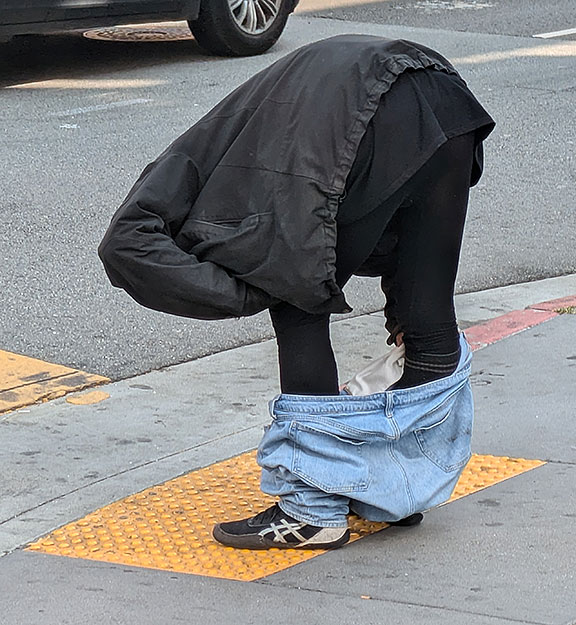
An all too common sight in San Francisco these days, someone in the midst of a “fentanyl freeze.”
San Francisco is famously having a drug problem. It’s decades old, but it is also quite new in that the arrival of synthetic opium in the form of fentanyl has been killing drug users at an unprecedented rate. The anti-overdose drug Narcan is now readily available and many people are carrying it around to try to save the lives of people who are obviously dying on our streets. It can be rather bleak walking past the blocks where police seem to have ushered the most desperate drug users to congregate. It is not uncommon these days to see people in almost any part of town doing the “fentanyl freeze” where they are rooted, standing stock still but bent completely in half as their upper torso has descended towards their knees, unable to sustain an upright position while experiencing the intense high of a fresh dose. It’s very sad, to say the least. But our opioid addiction crisis covers the country, and by all accounts is as bad or worse in many of the most abandoned and poverty-stricken rural areas of the midwest and the south in addition to the inner cities.
Ghosh has an interesting point about this too: “There is another, very important, way in which the contemporary American experience rhymes with the situation in nineteenth century China: the loss of people’s sense of their place in the world, and the dissipation of long-held beliefs in the centrality and primacy of their country, not just as the world’s paramount economic, political and military power but also as a model of good governance.” (p. 298). In the 1840s, the decade just before the California Gold Rush, China was subjected to two brutal wars that forced the ruling emperor to allow British, US and Dutch merchants to sell opium freely in their country (and forced the Chinese state to cede Hong Kong for a century to the British as a colony). Unsurprisingly it led to the opium addiction of millions of Chinese; combined with the wars and the national humiliation and confusion that spread widely in that decade, tens of thousands of young Chinese were ready to leave and try something new when news of gold in California arrived. The opium trade came with the dramatic influx of migrants from China and elsewhere starting in 1848. The drug was unregulated until 1914, when, following the lead of the US colonial authorities in the Philippines who prohibited opium smoking in 1908, the US Congress passed the Harrison Narcotics Act and began drug prohibition for the first time.
After purchasing the Philippines from Spain in 1899, Washington soon discovered that it had acquired, along with these seven thousand islands, hundreds of state-licensed opium dens generating a substantial $500,000 in tax revenues from opium auctions open only to Chinese. Amid a violent interplay of opium traders, addicts, and their evangelical opponents, colonial officials were frustrated in their attempts to find a satisfactory solution. After attempting a laissez-faire approach, they finally settled for the mailed fist of all-out prohibition and the heavy policing it entailed. (p. 148) As legal opium imports increased to a hefty 134 tons in 1905, retail sales rose to an impressive $2.5 million, and smokers reached an unprecedented peak of 40,000. (p. 149)
It’s interesting that the United States chose to forego this revenue source and attempt to suppress the trade since many of its wealthiest families had deep connections to the opium business. Venerable families in the Boston area made their fortunes in the euphemistically known “China trade.”
… the big opium-trading clans of Boston—the Perkins, Sturgis, Russell and Forbes families, were all as intricately interrelated as the Mafia lineages of southern Italy. They called themselves ‘the Boston Concern’ and the eventual merger of their firms would make them the single biggest opium-trading network in China. The wealth they gained from the opium trade would establish them as core members of the elite circle that Oliver Wendell Holmes called ‘the Boston Brahmins,’ America’s closest equivalent to an aristocracy (p. 169) … Together, the two Delano brothers held a majority stake in the biggest American opium-trading company for decades. Under Warren Delano Jr’s leadership, Russell & Co. outdistanced every other American company in its opium holdings. In 1843, after returning to the United States as an immensely wealthy man, Warren Delano Jr married Catherine Lyman, daughter of a distinguished Massachusetts family. The couple had many children, including a girl, Sarah, whose only son, Franklin Delano Roosevelt, became the thirty-second President of the United States. (p. 185-186)
The British Empire depended on opium revenues for the lion’s share of its budget from the late 1790s to the 1880s, especially after the 1830s when opium became the principal export of British India. One of the key banking partners of this opium trade is one of today’s largest banks, HSBC. In fact, as Ghosh ably notes, Mumbai, Singapore, Hong Kong, and Shanghai were all initially sustained by opium sales.
This ingenious system thus transformed a plant product, forcibly extracted from Indian peasants, into an item whose value kept multiplying as it was siphoned through China towards the West. The bills issued by the Company, and by banks like Baring Brothers in London, were the crucial instrument that tied together the entire system of commodity trade, ranging from cotton produced by enslaved African Americans to opium supplied by Indian peasants. The functioning of this system of purportedly free trade thus depended crucially on enslavement, coerced labor, smuggling and black markets. (p. 77)
It also depended on the blind destruction of millions of people very far from the United States or England. The logic of the market made this an acceptable outcome and anyway the logic of white supremacy helped justify all sorts of barbaric behavior as “civilized.” Ghosh reminds us that it was “not considered untoward” to inflict harm on other peoples in faraway places. In a country where Native Americans were being dispossessed and murdered with impunity, and where millions of enslaved Africans were being coerced by a regime of incredibly brutal cruelty to produce enormously profitable cotton crops, selling opium to the distant Chinese probably didn’t seem especially bad.
Ghosh nails it: “There could be no clearer summation of the most important accomplishment of the doctrine of Free Trade—the erasure of all ethical constraints in regard to profit-making.” (p. 207) . . . “That opium played a crucial role in sustaining colonialism in Asia is largely forgotten today, because European empires have been astonishingly successful at whitewashing the historical record.” (p. 260)
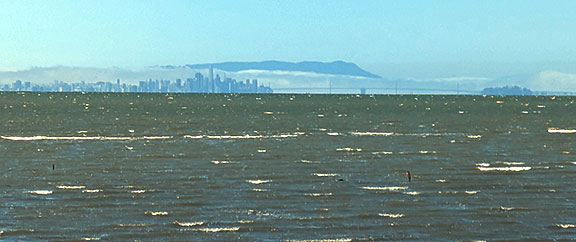
San Francisco skyline and Bay Bridge 25 miles across the Bay, fog pouring in between City and Mt. Tamalpais in background.
I like to point out to anyone I talk to that the toothpaste (of historical knowledge, whether you want to call it Critical Race Theory, or anticolonial studies, or simply telling the truth about genocide and slavery as the fundamental foundations of modern life) has been squeezed out and can’t be put back in the tube, no matter how frantic (or violent) the reactionaries become. Amnesia has had a long and successful run, but if anything can be said about the last fifty years, it’s that a whole shit-ton of amazing, revelatory history has been published and disseminated. Another case in point is Ned Blackhawk’s excellent The Rediscovery of America: Native Peoples and the Unmaking of U.S. History that came out in 2023. He echoes Ghosh’s point about the historical record here:
Illusions of discovery have obscured history’s more important insights. The thoughts of Europeans have often dominated narratives of history. Such narratives erase not only Indigenous peoples but also the transformations emanating from colonial settlements, which radiated deadly change. (p. 77)
But for our purposes, Blackhawk helpfully makes the connection between the seizure of the Philippines, often thought of as the “beginning” of a US imperial push, and the long history of genocidal aggression that took most of North America from its original inhabitants.
As [Theodore] Roosevelt championed, the ideologies that had guided U.S. continental expansion also sanctioned imperialism: “The reasoning which justifies our having made war against Sitting Bull also justifies our having checked the outbreak of [Filipino revolutionary General Emiliano] Aguinaldo and his followers.” If the United States “were morally bound to abandon the Philippines,” he continued, “we were also morally bound to abandon Arizona to the Apaches.” (p. 375-6)
Well… yeah! Quoting Teddy Roosevelt helpfully brings us back to the profound racism at the heart of the United States long after the Civil War was over (obviously it’s going strong in 2024!). Combined with the technological transformations that erupted in the late 1800s, the U.S. went from a culture of fragmentary records and local constables to a nation with centralized criminal files, wired cities, nascent intelligence services, and systematic social indices. A big part of the latter was the supposedly scientific field of eugenics, which starting in the 1890s embarked on a decades-long project of classifying people by race and intelligence, primarily to justify ending open immigration. The emergence of the telegraph and typewriters and then telephones in the mid-1870s allowed the transmission and recording of textual data more accurately and faster than ever in history. The invention of the punch card in 1889 and the later founding of IBM radically increased data handling capacity at the turn of the 20th century. By 1895 photographic inventions allowed for a factory to produce 147,000 photo prints a day. These technologies came to underpin extremely flaky data gathering in the name of eugenic science, but armed with this so-called data, the racist propagandists who were determined to keep America a white man’s country pursued their efforts to restrict immigration nationally.
In The Guarded Gate, Daniel Okrent tells the history of the men who funded and defined the Immigration Restriction League starting in the 1890s, an organization that dovetailed with early efforts to understand genetic science, but whose overt racism soon overwhelmed the scientific process. Okrent describes the three-decade history of the restriction movement:
…leadership had been handed off from northeastern Protestant aristocrat to northeastern Protestant aristocrat. Henry Cabot Lodge ran the first leg of the race, abetted by Joe Lee, Prescott Hall, Robert Ward, and the other men of the Immigration Restriction League. Madison Grant [author of the screed The Passing of the Great Race] picked up the baton and then handed it off to Charles Gould. John Trevor would take the anchor leg of the relay. Abetting the teams’ efforts throughout was the scientific auxiliary: Charles Davenport, Fairfield Osborn, Carl Brigham. (p. 324)
From the 1890s to the passage of the Johnson-Reed Immigration Act of 1924, the campaign to restrict immigration and fan the flames of racial fear created a climate of growing hysteria in the United States. The deeply racist attitudes promulgated by white Americans in the Philippines, which also informed the new techniques of social control pioneered there, soon migrated back to shape the culture that emerged from the turmoil of pre- and post-WWI.
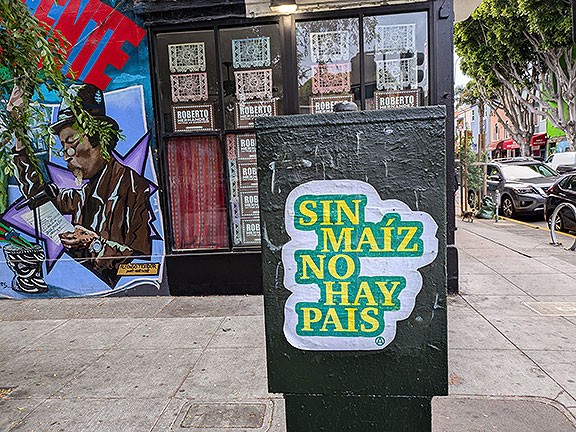
My colorful corner a half block from home in the heart of the Mission, a delightfully immigrant-heavy neighborhood.
A key figure who is gaining some notoriety thanks to McCoy and other recent histories like Adam Hochschild’s excellent American Midnight is a guy who started as an obscure file clerk in the Philippines under Taft and developed techniques that he would use to help shape the security state that emerged in the wake of the Russian Revolution and WWI. [Adam Hochschild will be speaking October 9 at 518 Valencia in our Shaping San Francisco Public Talk on the original post-pandemic politics a century ago.] Ralph Van Deman rose to head Military Intelligence during WWI where he forged a two-way relationship with the vigilantes of the American Protective League, using the citizen brigades to gather information and also giving them direction. Later he was sent to the Versailles Peace Conference to coordinate intelligence gathering for President Woodrow Wilson as he argued for his vision of a “League of Nations.” By 1929 Van Deman retired from the military as his efforts to expand domestic surveillance had been largely subsumed by J. Edgar Hoover and the early FBI, though he continued to act as a key node in a network of state and private anti-communist zealots in his retirement home in San Diego.
In her excellent book Right Out of California about the origins of modern conservatism in 1930s California, Kathryn Olmsted has this to say about Ralph Van Deman:
Like many conservatives, Van Deman supported one kind of expansion of federal power while opposing another. Stronger security agencies benefited the nation; stronger labor agencies harmed the economy and undermined business owners’ rights. This contradiction would characterize modern conservatism, and it originated in California’s [1933] farmworker strikes… Van Deman and his supporter believed that the international Red conspiracy had specifically targeted California. . . Besides drawing from a pool of local, state, and federal agents, the general also recruited and managed spies from private groups, especially business organizations and patriotic clubs. (p. 155)
During the decade he spent in the Philippines Van Deman became obsessed with the machinations of Japanese agents in the Philippines but also around the Pacific Rim. He was among the most ardent hawks who saw the rise of Imperial Japan as a threat to US supremacy in the Pacific. He was not unique and many of the politicians and military leaders who cut their teeth in the Philippines (Taft, General John Pershing, Harry Bandholtz) shared the racist assumption that white men were destined to lead the world. When Japan defeated Russia in their 1904-05 war, it greatly increased the anxiety among white elites. And the flipside was that Japan played its success to rally various movements around Asia to its side, claiming that Japan represented the larger interests of Asian peoples against the hegemony of Western imperialists.
Moon-Ho Jung, writing in Menace to Empire: Anticolonial Solidarities and the Transpacific Origins of the US Security State, presents an analysis of inter-imperial rivalry between Japan and the US as a choreographic background to the rise and fall of numerous revolutionary projects spanning the Pacific during the early 20th century. He cites McCoy’s big work on the Philippines extensively, but his focus is different:
As those officials [of the Philippine Constabulary, the Military Information Division, the Office of Naval Intelligence, the Bureau of Investigation, the Bureau of Immigration] sought endlessly for security, they glimpsed radical movements and interracial solidarities that could not but produce greater insecurity. That was the circular logic of national security, a nebulous and ridiculous conceit that signified racial anxieties and imperial insecurities. In that light, the search for US national security began long before the Cold War, articulated through and around legal regimes, state surveillance, and racial violence. That was the work of the US state, which has since become an unparalleled behemoth subjecting racialized and radicalized peoples around the world—demonized and criminalized over the last century as anarchists, communists, gooks, terrorists—to unrelenting violence, all in the name of national security. That is the United States, the US empire, then and now. (p. 20)
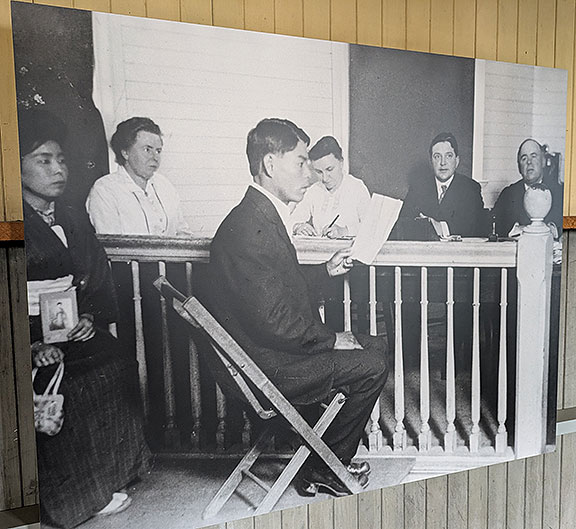
Typical interrogation scene for Asian immigrant at Angel Island in San Francisco Bay between 1904-1941.
Providing detailed accounts of South Asian radicals from India’s Ghadar Party, Korean nationalists who attacked a Japanese-sponsored lobbyist in San Francisco, and Japanese radicals who circulated around Hawai’i, Hong Kong, the Philippines, and the United States, he brings steady undercurrents of radical resistance to the foreground. Still, the context of the early 20th century put the brewing conflict between Japan and the US at center stage:
No matter what the local Japanese said or how they acted, their role within the US empire was predetermined or overdetermined: they posed the greatest threat to US national interests across the Pacific. The racialization of the Japanese as subversive and revolutionary agents, originally in the US-occupied Philippines and then in US-occupied Hawai‘i, reflected and reproduced that conjecture and conclusion. (p. 180) … That racial perception of Japanese incursion prompted many US state governments to pass laws prohibiting “aliens ineligible to citizenship” [as codified by the 1924 Johnson-Reed Immigration Act] from owning real property, a largely anti-Japanese measure likewise adopted in the Philippines. (p. 230)
Ralph Van Deman makes an appearance in Jung’s account too, this time focused on his participation in the 1918 crackdown on so-called “Hindu-German” conspiracies:
South Asian revolutionaries’ links to Russia and Japan seemingly magnified the prospect of sedition and revolution against the United States. In May 1918, Ralph H. Van Deman, the head of military intelligence who long feared Japan’s malevolent influence in the Philippines, forwarded to the Labor Department a comprehensive report on “Hindu-German activities and suspects,” warning that “the Hindus are preparing to take an active part in strikes and other anti-war demonstrations fomented by the IWW, Bolsheviki . . in this country, about May first.” (p. 223)

This warning, like subsequent ones whipped up by A. Mitchell Palmer in early 1920, highlighted attacks and protests that never materialized. But the climate of fear and loathing saturated the country. In California, Senator James Phelan centered his re-election campaign on the anti-Japanese slogan “Keep California White,” and followed that with details on how supposedly Japanese farmers had taken over a large percentage of arable land in the state. Nothing could be further from the truth, but that didn’t stop the California state legislature, along with many others, from passing laws that banned “aliens” from owning California land.
Alfred McCoy argues that the techniques honed in the Philippines became the essential building blocks of the 20th century security state that the US became. He even identifies methods used in the Philippines that can be recognized in the deplorable COINTELPRO project of the FBI to disrupt and destroy radical movements among African Americans and anti-war youth.
By penetrating these radical organizations, the constabulary sought to destroy them from within through psychological profiling, disinformation, black propaganda, and entrapment. Most important, the U.S. regime strove to corrode the tenuous bonds of trust that held the upper echelons of these groups together, depriving them of effective leadership. In sum, after 1907 the constabulary’s main mission shifted from counterinsurgency to psychological and information warfare. (p. 176) …
After years of pacifying an overseas empire where race was the frame for perception and action, colonial veterans came home to turn the same lens on America, seeing its ethnic communities not as fellow citizens but as internal colonies requiring coercive controls. Within twelve months of introducing stringent security measures, President Wilson’s wartime America circa 1918 came to bear a marked resemblance to Governor Taft’s colonial Philippines circa 1901. Both had similar arrays of legislation that limited civil liberties and secret services that engaged in arbitrary arrests, rigid censorship, mass surveillance, covert penetration, and black operations. Although it was established as a seemingly transitory wartime measure, this domestic security apparatus would persist for the next half century as a defining feature of American political life. . . In this process of imperial mimesis, a state such as the United States that creates a colony with circumscribed civil liberties and pervasive policing soon shows man of those same coercive features in its own society. As the metropole’s internal security apparatus starts to resemble the imperial, so its domestic politics begin to exhibit many attributes of the colonial. (p. 294-295)
Now we live in “surveillance capitalism,” where our every preference and whim is carefully cataloged and used to sell us more crap. But it can just as easily be used to control political protest, organizing, workplace resistance, and all the mechanisms that are the main weapons of working class and popular opposition to the status quo. Palantir is a private “security” firm with capacities that far exceed anything Van Deman could imagine. And Peter Thiel, its founder, and his buddies like the execrable Balaji Srinivasan have big plans to create a series of enclaves where they can “exit” to what they’ve labeled “The Network State”—places where their fantasies of class domination firmly rooted in eugenicist falsehoods that frame recurrent hysterias against “others” can have free reign. Ugh.
The first information revolution of the late 1800s has morphed into today’s panopticon state, a behemoth of data gathering by private interests whose main purpose is to keep the boundaries of our lives inside shopping and working, or moving from one to the other between lengthy periods of watching TV or sleeping. It all sounds so bleak and daunting. And yet most of us know that our lives far exceed the flimsy boundaries imposed by these neo-Skinnerian behaviorist dystopian engineers.
I’m not going to wrap up with a pollyannish exhortation about how we are on the cusp of some amazing break with all this, though I would like to believe it’s possible. But I can say with certainty, as ballistic missiles fly across the Middle East and war is widening steadily there and on Europe’s eastern border, that things are extremely fragile. The massive floods from Hurricane Helene in Florida, North Carolina, and Georgia are the new normal. The long neglect and decay of the common good is going to be very hard to reverse—and yet that is the task at hand. Life could be so wonderful! Why do we keep tolerating such a disaster? Why are the lunatics allowed to keep running the asylum (who wants to vote for any of these awful people)? Why do we tolerate the bizarre new McCarthyism that makes basic solidarity with Palestine unmentionable in mainstream politics? What kind of insanity is this? Turns out this insanity is amazingly similar to what’s been going on for more than a century, as the works I’ve cited in this post make clear. At every juncture, people of good will and creativity are murdered or silenced so criminals, gangsters, and sociopaths of unmeasurable cruelty can pretend they deserve to rule.

Who pays for this shit?
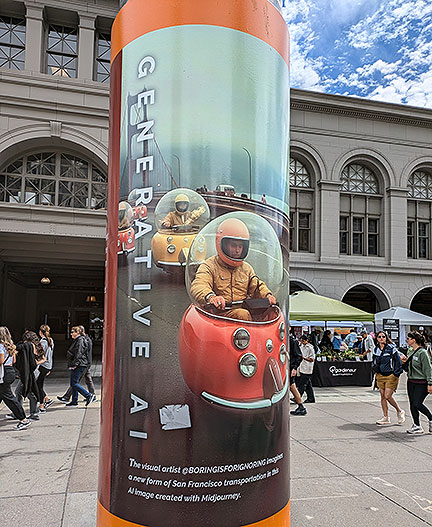
Weird advertising for the chimerical new industry of San Francisco right in front of the Ferry Building… sheesh!












That’s a damn good last sentence, and a damn good epitaph for humanity.
Electoral politics is incontrovertibly horrific, sad, and a waste of reformer attention. Why give psychic space to such ass clowns – and that includes Harris, who like the con artist Obama before her, betrayed the legacy of smart, progressive parents (especially her father) to become a Manchurian candidate of faith, bombs, and big business.
However, nothing wrong with being people of “good will and creativity.” The murdered martyrs cannot come back to life, and the ex-casino owner may still be shouting out nazi rhetoric, but having a good life has been the best form of revenge.
Always love your stuff man
One of your best blogs ever. Making many interesting connections.
I knew about McCoy’s early work about Asian heroin trade.
I expect you heard about the Just Stop Oil
protesters absurdly heavy prison sentences for harmlessly throwing paint?
https://www.newstatesman.com/thestaggers/2024/10/did-the-just-stop-oil-soup-throwers-deserve-their-sentence
Keep up the good work!
One of your best ever blogs. I knew about
McCoy’s early work when it first came out.
Expect you know about the Just Stop Oil protesters in U.K.
sentenced to 2 years in prison for totally
harmless throwing paint https://www.newstatesman.com/thestaggers/2024/10/did-the-just-stop-oil-soup-throwers-deserve-their-sentence ( not the greatest article).
Keep up the good work Chris.